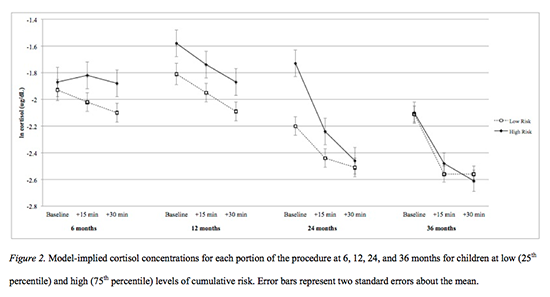Dr. Gariepy examines how the organization of the stress response system, conceived as a physiological interface between the organism and its environment, is shaped by experience and relates to individual differences in patterns of socio-emotional adaptation. The hypothalamic-pituitary-adrenal (HPA) axis is one of the principal systems that mediates the physical response to challenge. The HPA axis initiates a release of cortisol in the blood system in response to novel events, unfamiliar circumstances, or distressing conditions. HPA axis activity is linked to stress and adverse care-giving environments, but less is known about whether more distal forms of adversity are associated with individual differences in this activity.
In one recent study, Dr. Gariepy examined the relation between exposure to cumulative distal risk and the activity of the HPA axis across early childhood. Studies indicate that HPA axis activity is responsive to challenge in infancy, however, in early childhood, the threshold for response changes. In the experience, children participated in one or more challenging, developmental-appropriate tasks designed to elicit a physiological stress response. Children were evaluated at ages 6, 12, 24, and 36 months. At six months, babies participated in the still-face procedure, during which mothers look at the child for 90 seconds without facial movement or vocalization. They also participated in an arms restraint task, where mothers gently hold down the child’s arms for two minutes while maintaining a neutral expression. At 12 months, the task involved two episodes of maternal separation and, at 24 months, children participated in a barrier task, in which an appealing toy is taken from the children and placed behind a transparent barrier for two minutes. Finally, at 36 months, children were left alone for two minutes with a wrapped present and attempted to refrain from opening the present. Levels of cortisol in blood and saliva are correlated, so saliva samples were taken to study HPA axis activity.
 Distal risk was measured through self-reporting by the child’s primary caregivers to assess five common risk factors (marital status, maternal education, pre-tax household income, number of children in the household, and maternal age at childbirth). Dr. Gariepy and the research team found that cumulative risk was positively correlated with higher cortisol levels at ages 6, 12, and 24 months, although there was an overall pattern of decline as the children increased in age. The team also discovered that both male gender and African American race correlated with higher cortisol levels at certain measurements. Among children exposed to low levels of cumulative distal risk, baseline levels of cortisol were lower at 24 months than at 6 months. In Dr. Gariepy’s study, children exposed to high levels of cumulative distal risk displayed higher baseline levels of cortisol at 12 months than at 7 months, demonstrating an association between higher baseline cortisol levels and lower income. Results suggest that at 6, 12, and 24 months, the children that exhibit higher levels of HPA axis activity than their peers speaks to the offsetting strength of environmental adversity and its capacity to prompt endophenotypic recalibration.
Distal risk was measured through self-reporting by the child’s primary caregivers to assess five common risk factors (marital status, maternal education, pre-tax household income, number of children in the household, and maternal age at childbirth). Dr. Gariepy and the research team found that cumulative risk was positively correlated with higher cortisol levels at ages 6, 12, and 24 months, although there was an overall pattern of decline as the children increased in age. The team also discovered that both male gender and African American race correlated with higher cortisol levels at certain measurements. Among children exposed to low levels of cumulative distal risk, baseline levels of cortisol were lower at 24 months than at 6 months. In Dr. Gariepy’s study, children exposed to high levels of cumulative distal risk displayed higher baseline levels of cortisol at 12 months than at 7 months, demonstrating an association between higher baseline cortisol levels and lower income. Results suggest that at 6, 12, and 24 months, the children that exhibit higher levels of HPA axis activity than their peers speaks to the offsetting strength of environmental adversity and its capacity to prompt endophenotypic recalibration.
The neuroendocrine branch of the stress hormone is known in animals and humans to undergo a progressive hypo-responsive period early in life that supports the anabolic needs of the developing individual. Dr. Gariepy’s research has shown that the rate at which this neuroendocrine activity is suppressed from 6 to 36 months of age is reduced in proportions that match the extent of exposure to adversity early in life.
 Dr. Jean-Louis Gariepy is an Associate Professor in the Developmental Psychology Program within the Department of Psychology and Neuroscience at UNC Chapel Hill. His work focuses on the developmental emergence of regulative capacities in the child by integrating the physiological, emotional, and behavioral aspects of regulative capacities, including the parent-child contextual factors that contribute to the acquisition of these capacities. Learn more about his research online.
Dr. Jean-Louis Gariepy is an Associate Professor in the Developmental Psychology Program within the Department of Psychology and Neuroscience at UNC Chapel Hill. His work focuses on the developmental emergence of regulative capacities in the child by integrating the physiological, emotional, and behavioral aspects of regulative capacities, including the parent-child contextual factors that contribute to the acquisition of these capacities. Learn more about his research online.

